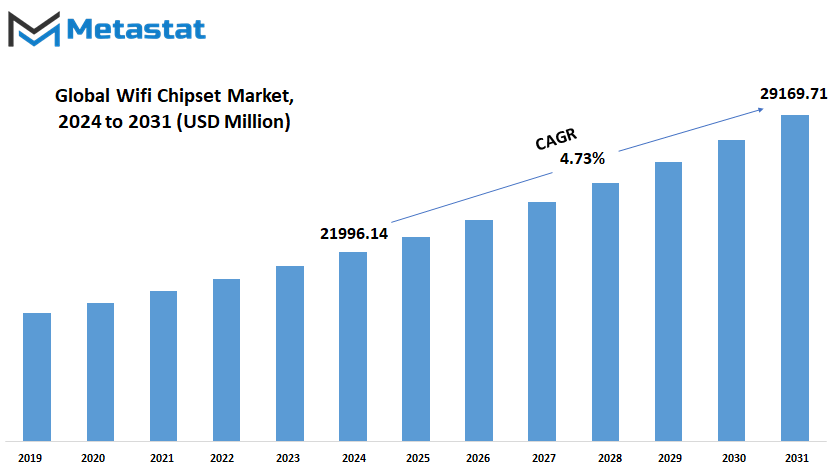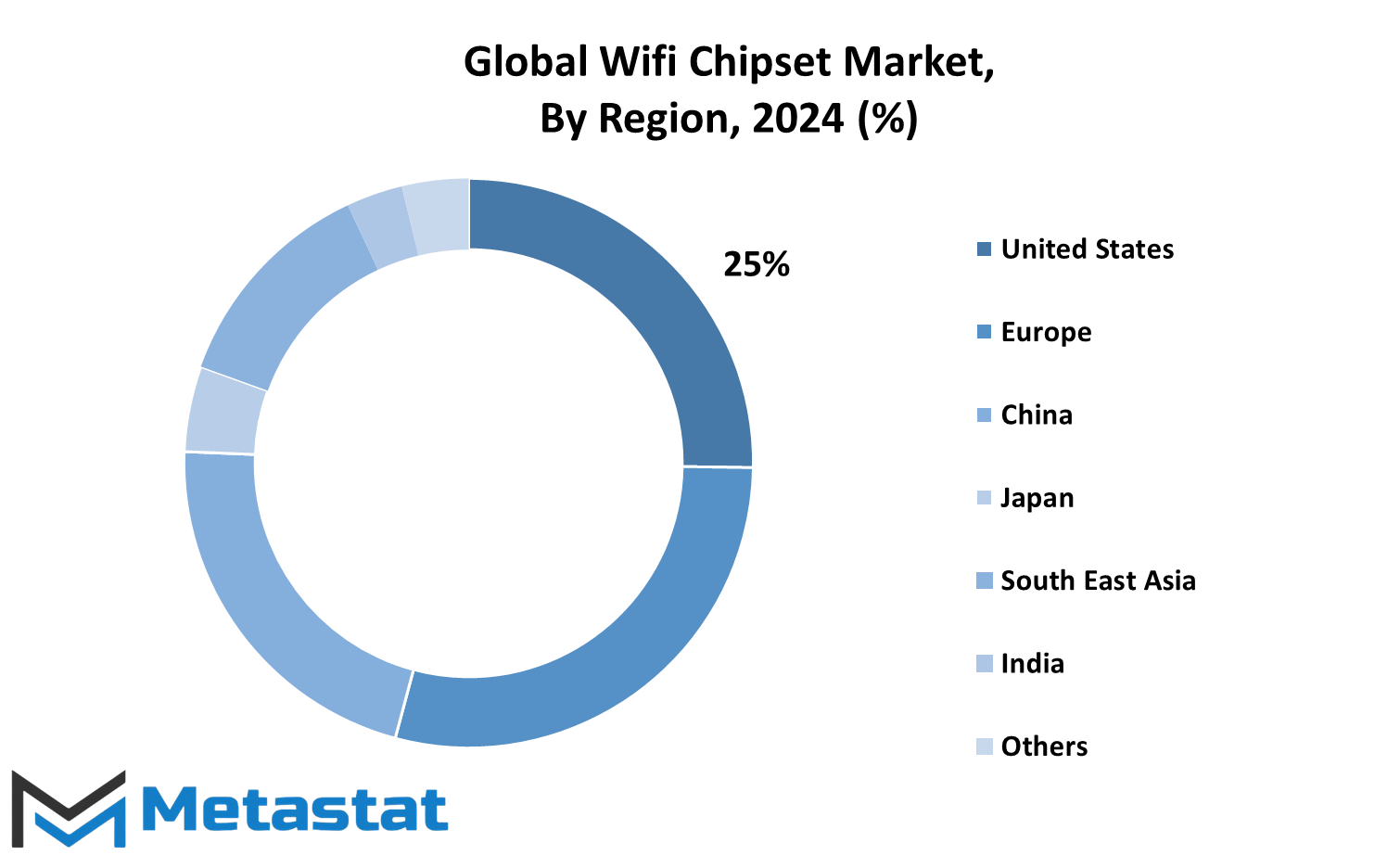MARKET OVERVIEW
The Global Wifi Chipset market is a fast-paced technology-related industry aimed at ensuring uninterrupted wireless communications. The chipsets deployed in the device are mainly to allow communication with a wireless network; hence, they help efficiently transfer data and connectivity through a broad range of applications. The wifi chipset provides the core backbone for wireless communications through various devices such as smartphones, laptops, routers, IoT devices, as well as increasingly large percentages of smart appliances. Based on increasing demands for a higher internet access speed with multiple devices interconnected, global market demands will define Wifi chipset and be a centerpiece of modern communication technologies. End.
Wifi chipsets are designed to meet the specific requirements of wireless communication, including bandwidth efficiency, energy consumption, and compatibility with evolving standards such as Wi-Fi 6 and Wi-Fi 7. These chipsets operate in a highly competitive industry landscape where manufacturers constantly innovate to offer solutions that deliver better performance, lower latency, and enhanced network security. The continuous thrust for high-speed internet and strong network connectivity will continue to fuel advancements in chipset technology. Beyond consumer electronics, the Global Wifi Chipset market covers automotive, healthcare, industrial automation, and smart cities, among others.
For example, in the automotive industry, wifi chipsets are critical for V2X communication, which is a key component in developing autonomous vehicles. In the same way, in healthcare, these chipsets allow for real-time data exchange in telemedicine and remote monitoring devices. As more industries implement smart technologies and connected systems, the need for special-purpose chipsets that can serve their needs will expand considerably. The Internet of Things will further expand the scope of this market.
The next billion devices that come online in the coming years will mean that there is a bigger need for efficient, low-power wifi chipsets. Devices, from home automation systems to industrial sensors, will be dependent on very advanced chipsets to enable reliable and secure connections, given the increasingly dense environments in which they will need to operate. Moreover, the transition to smart cities, which leverage wireless communication for infrastructure management and public services, will create new opportunities for wifi chipset manufacturers. Geographical dynamics in the Global Wifi Chipset market will also change based on regions focusing on investments in their wireless infrastructure. Asia-Pacific, for example, would become one of the prime regions that will lead and gain strength because of this region having a large population, adopting technology at lightning speed, and having heavy manufacturing sectors. North America and Europe would continue research and development for sustaining their strength in the competition in such a tech-intensive industry.
In conclusion, Global Wifi Chipset will have more of an influence over how people and devices talk, thereby shaping various sectors and applications. With further reliance on wireless connectivity by day-to-day life, the market is bound to become increasingly complex and vital in the years ahead.
Global Wifi Chipset market is estimated to reach $29169.71 Million by 2031; growing at a CAGR of 4.73% from 2024 to 2031.

GROWTH FACTORS
The Global Wifi Chipset market is experiencing significant changes due to evolving technological advancements and growing consumer needs. One of the main drivers that is helping in its growth is a rise in demand for high-speed internet connectivity. Because of the increasing dependency on digital platforms for work, education, and entertainment among more people, seamless rapid wireless communication has become imperative both at homes and at workplaces. The increasing number of smart devices further emphasizes the need for efficient WiFi solutions, as these devices require stable and reliable communication to function effectively.
The proliferation of the Internet of Things (IoT) is another critical factor that affects the growth of the market. From smart home systems to industrial automation, IoT devices heavily rely on robust wireless networks. With the increase in IoT applications, the demand for advanced WiFi chipsets to handle increased traffic and ensure reliable performance also increases. This is a bright future for the industry, with manufacturers looking to develop chipsets that can meet the increasing demands for connectivity.
But, market is not free from barriers. One major obstacle here is the cutthroat competition between chipset makers that compresses prices. Such competitiveness creates a big problem: to make the product more affordable while introducing something new into it. Also, regulatory hurdles and restrictions concerning the spectrums for wireless communication create a significant barrier in the growth of the market. Governments and regulatory commissions usually put some tough conditions on the use of spectra, which hinder the invention and introduction of new technology.
Despite these challenges, the future of the Global Wifi Chipset market is promising. The development of WiFi 7 technology is going to revolutionize the industry. This next-generation WiFi standard promises to deliver faster speeds and improved connectivity, catering to a wide range of applications. Its ability to handle multiple devices simultaneously with minimal interference will make it an attractive solution for both consumers and businesses. Adoption of WiFi 7 might open many opportunities to the manufacturers, especially in the areas of health care, gaming, and smart cities.
In conclusion, in spite of the competition faced by this Global Wifi Chipset market and regulatory pressures, strong growth is there in a rising demand in high speed internet and it is constantly expanding IoT as well. The introduction of advanced WiFi 7 promises to bolster the market prospect further more, opening gateways toward innovative solutions capable of driving the future development of wireless communication.
MARKET SEGMENTATION
By Type
The Global WiFi Chipset Market is expected to grow considerably with the increasing reliance on wireless technology in modern connectivity. As technology advances, so does the demand for faster, more efficient, and reliable internet access. This can be attributed to the rising dependency on connected devices in daily life. A WiFi chipset is the heart of any wireless communication system in devices, and the role that these chipsets play is pivotal in the way individuals and industries access and use the internet.
The market spans by type different standards, all of which serve to address specific performance requirements. WiFi 4 (802.11n) and previous versions provided foundational wireless capabilities but are increasingly being left behind by newer technologies. WiFi 5 (802.11ac) brought important advancements in terms of speed and efficiency, hence widely adopted for personal and commercial use. Recently, WiFi 6, or 802.11ax, has emerged due to its capacity for dense networks, increased data rates, and energy efficiency. It's particularly helpful in smart home environments, offices, and public areas where multiple devices compete for bandwidth.
WiFi 7 is then expected to disrupt the market with superior speeds, lower latency and greater capacity. Being a newly emerging standard, WiFi 7 promises to address the insatiable demand for networks that offer high performance on applications like virtual reality and augmented reality, as well as industrial automation. Potential seamless connectivity support in high density scenarios place it as next-generation disruptor for next-generation technologies.
The proliferation of Internet of Things (IoT) devices and the emergence of smart cities are driving the global WiFi chipset market. These advancements demand strong wireless infrastructure that can support various applications, ranging from home automation systems to large-scale industrial networks. Furthermore, AI and machine learning further enhance the demand for reliable wireless communication that supports data-intensive operations.
As industries and individuals go further embracing connected solutions, the emergence of WiFi standards will continually be crucial to meeting the demand of modern living and workspaces. With continuous innovation on the horizon and the onset of WiFi 7 rolling out, the global market for WiFi chipsets will continue to grow and advance in shaping the future of connectivity for years to come.
By Band Type
The Global Wifi Chipset Market is growing at a great scale, driven by advancements in technologies and the increased need to have reliable wireless connectivity in the market. It gets fueled by the expanded usages of connected devices on various industries, such as consumer electronics, automotive, healthcare, and smart home systems. A world embracing digital transformation calls for the ever-growing awareness of Wi-Fi chipsets for foundational components in facilitating seamless communication. These chipsets are vital for allowing the accessing of high-speed internet for smooth data transfer and connectivity to underpin modern lifestyles and businesses.
By type, the market is segmented into Single Band, Dual Band, and Tri-Band. They have different capabilities to satisfy different needs. Single band supports one frequency band and therefore can be used in scenarios where cost and simplicity come in handy. On the other hand, Dual Band chipsets allow access to two frequency ranges, resulting in better performance, lower interference, and higher efficiency of the network. Tri-Band chipsets take this to a higher level as they work on three frequency ranges and are ideal for more data load, hence suited for environments that require constant, high-speed connectivity. These configurations will accommodate the growing need for better performance from users and industries, where Wi-Fi is increasingly utilized for more critical functions.
The Global Wifi Chipset market is a critical part of technological advancement, filling the gap between devices and the networks they rely on. Segmentation by band type ensures that a wide range of applications can benefit from tailored solutions, forming the basis for a future defined by seamless and robust wireless communication. As industries and consumers alike embrace smarter solutions, the demand for advanced Wi-Fi chipsets is poised to grow, reinforcing their importance in shaping the connected world.
By Chipset Type
The Global WiFi Chipset market is going to play a very important role in shaping the future of wireless connectivity. As technology continues to advance rapidly, WiFi chipsets have become the backbone of the modern digital world, allowing uninterrupted communication across an array of devices. These are the chipsets used for enabling devices to connect to a wireless network; thus, offering safe, fast internet. Market The market is led to deliver solutions based on the increased requirements from clients about the faster data, high connectivity, and maximum compatible devices.
System-on-Chip or SoC Design SoC designs hold the prominent portion of this market. SoCs combine all those critical components necessary for Wi-Fi functionality in one single chip, which makes SoCs a favorite choice in compact and energy-efficient devices. The SoCs can efficiently accommodate various functionalities, making them even more suitable for smartphones, tablets, and smart home devices. The demand for SoC WiFi chipsets will be further driven by consumers looking for smarter and more efficient solutions. Advancements in SoC technology are expected to offer better performance, reduce power consumption, and be compatible with the next generation of wireless standards.
Stand-alone chipsets, however, remain well-positioned in this fast-changing landscape. These chipsets focus only on providing Wi-Fi connectivity, and they will be crucial in applications that necessitate dedicated wireless performance. In most industrial settings, automobile systems, and large scale network infrastructure, they will be applied since specific requirements dictate the need for a solid connection. In most industries nowadays, with automation and IoT on the rise, standalone WiFi chipsets will be tasked to support increasing network requirements so that there is continuous communication in critical environments.
Going forward, Global WiFi Chipset market is anticipated to enjoy the roll-out of the advanced wireless technologies such as WiFi 6 and WiFi 7. These are the next-generation standards that promise higher speeds, lesser latency, and efficiency in the increasingly connected world. The expansion of smart cities and the proliferation of connected devices can be expected to increase, along with the adoption rate of augmented and virtual reality applications, further amplifying demands for innovative WiFi chipsets. As the Global WiFi Chipset market continues to evolve due to changing requirements of the technology and consumers, wireless communication systems will be supported by this market as one major driver of progress.
By Application
As the technological world is speeding in breakneck pace, the world market of Wifi Chipsets, too, is speeding. These chipsets have emerged as really central in providing solutions efficiently when supporting multiple applications that have added to a change in the way that devices are now designed to talk and act between personal and professional spaces.
The first force driving the Global Wifi Chipset market is smartphones and tablets. As these devices have become unreplaceable in daily lives, there is a need to drive robust and energy-efficient chipsets. The chipsets for Wifi ensure fast, consistent internet access, which happens to be an essential requirement of streaming, video calls, or various mobile applications. Laptops and desktops also heavily benefit from advancements in the technology of Wifi chipsets. They rely on those components for seamless connectivity, which is essential for work, education, and entertainment purposes.
Another category that's growing at an explosive rate comprises smart home devices. With dependable Wifi connections, smart speakers, thermostats, and security systems would be able to function. These chipsets let the smart home become a single integrated ecosystem, making efficiency and energy management feasible. It also consists of networking appliances, including routers and access points. As high-speed internet needs are constantly growing around the globe, Wi-Fi chipsets also become advanced enough to support increasing loads and faster speeds.
The influence of this market in the Global Wifi Chipset will be visible in every type of IoT device; be it a wearable health track, or an industrial sensor embedded within its processes. Chipsets help in the wireless communication depended on by these devices that help smooth data transfer, hence enabling synchronization. Autos and their transportation systems increasingly utilize it. Wifi chipsets support applications such as in-vehicle entertainment, navigation, and vehicle-to-vehicle communication, making transportation safer and more enjoyable.
Industrial applications are leveraging Wifi chipsets to enhance productivity and streamline operations. Factories, warehouses, and other industrial settings use wireless communication for monitoring, automation, and real-time decision-making. Beyond these sectors, the Global Wifi Chipset market includes additional applications that further emphasize its importance, such as healthcare and public infrastructure.
As technology is further advanced, the Global Wifi Chipset market will continue to shape a connected future. Influence across all these applications ensures that both individuals and industries can tap into efficient, reliable, and fast wireless communication solutions, opening up a route to smarter and more innovative systems globally.
|
Forecast Period |
2024-2031 |
|
Market Size in 2024 |
$21996.14 million |
|
Market Size by 2031 |
$29169.71 Million |
|
Growth Rate from 2024 to 2031 |
4.73% |
|
Base Year |
2022 |
|
Regions Covered |
North America, Europe, Asia-Pacific Green, South America, Middle East & Africa |
REGIONAL ANALYSIS
The global Wifi chipset market is expected to be highly growth-oriented due to the speedy development of technology and rising demand for seamless connectivity across all industries. Regional analysis shows varying patterns of growth and opportunities and reflects the specific characteristics of each region. Geographically, the market can be divided into North America, Europe, Asia-Pacific, South America, and the Middle East & Africa, with each of these regions contributing uniquely to the growth of the industry.
North America continues to be at the top, with the existence of significant technological centers and a high demand for smart devices. The U.S. is at the top, supported by significant investments in research and development and a strong consumer base. Canada and Mexico are also at the forefront, with increased adoption of IoT devices and plans to expand the digital infrastructure. Connected homes, autonomous vehicles, and smart cities further drive the demand. Hence, North America is one of the most important regions for the global Wifi chipset market. Europe has a steady growth track, driven by advancements in wireless technology and government initiatives for digital transformation. This region is led by the UK, Germany, and France, focusing on innovation in industrial automation, healthcare, and education. Italy and other parts of Europe are also aggressively adopting modern Wifi solutions for smart manufacturing and public services.
The region's strategic focus on the reduction of energy consumption and connectivity enhancement goes well with increasing demand for efficient Wifi chipsets. Asia-Pacific is a vibrant and fast-growing market, mainly because of the presence of manufacturing giants and an ever-growing consumer base. Countries like India, China, Japan, and South Korea are leading the adoption of advanced Wifi technologies, with the government taking steps to enhance internet accessibility. Growing demand for smartphones, e-commerce, and smart appliances boosts demand, while investments in 5G technology keep on increasing the potential for the region to develop further.
Growth prospects also lie in South America, where Brazil and Argentina lead the pack. Household and business adoption of smart technology is revolutionizing connectivity standards across the region. Improving digital infrastructure and fostering economic growth are among the factors driving the global Wifi chipset market here.
Last but not least is the Middle East & Africa region - unique in its own right, as countries in the GCC, along with Egypt and South Africa are focusing on internet expansion and deployment of smart solutions. Smart city development and the introduction of cutting-edge technology into industries create an increased requirement for Wifi chipsets as the region will continue its role in the overall development in the global market.

COMPETITIVE PLAYERS
The Global WiFi Chipset market is booming with unprecedented growth rates since there has been increasing demand from almost every industry in recent years to have dependable high-speed wireless connectivity. This factor, wherein WiFi chipsets form a critical basis to allow for wireless communication, becomes vital with the penetration of smart devices and the IoT alongside sophisticated networking solutions. As technology advances and shapes the future, the competitive players within this market are placing themselves in a position to meet these emerging needs with innovative solutions.
The major industry players for WiFi technology are Qualcomm Technologies, Inc., Broadcom Inc., Intel Corporation, and MediaTek Inc. These innovations in WiFi technology are led by these players, who develop chipsets that provide increased speeds, better energy efficiency, and improved security protocols. This evolution not only addresses the needs of the current world but also builds up for future applications, such as autonomous systems, smart cities, and next-generation communication networks. For instance, Qualcomm's dominance in WiFi 6, and Broadcom's entry into integrating advanced capabilities demonstrate companies' strategic positioning of their offerings to stay ahead.
Similarly, companies like Texas Instruments Incorporated and Marvell Technology Group Ltd. are seriously doing it to build further on WiFi chip capabilities. Companies are improving industrial, automotive, and consumer applications with maximum performance, thus filling an increased expectation on the availability of robust wireless connectivity. On the smaller but high-impact playing field, firms like Espressif Systems and Nordic Semiconductor are beginning to find a niche for low-power applications primarily in the IoT ecosystems.
With an explosion in the use of connected devices, WiFi chipsets have to support more load and smoother connectivity. For this, companies like Realtek Semiconductor Corporation and Huawei Technologies Co., Ltd. have progressed towards higher end features, which comprise mesh networking and multi-band support. However, companies like NXP Semiconductors and Skyworks Solutions, Inc. have focused strictly on some niche markets like medical devices and smart home applications.
As competition is heating up, these companies are becoming more cooperative and making strategic acquisitions. For example, Cypress Semiconductor is now part of Infineon Technologies AG, and the company has expanded its presence in IoT-based WiFi solutions. Renesas Electronics Corporation is also looking for partnerships to enhance its portfolio.
The Global WiFi Chipset market will be defined by 5G, edge computing, and artificial intelligence in the coming years. These technologies require seamless wireless communication, and this is where market leaders can innovate further. With a focus on addressing these futuristic demands, competitive players are well-positioned to define the next era of connectivity solutions, ensuring sustained growth for the industry.
Wifi Chipset Market Key Segments:
By Type
- WiFi 6 (802.11ax)
- WiFi 5 (802.11ac)
- WiFi 4 (802.11n)
- WiFi 3 and Earlier Standards
- WiFi 7 (Upcoming Standard)
By Band Type
- Single Band
- Dual Band
- Tri-Band
By Chipset Type
- System-on-Chip (SoC)
- Standalone Chipsets
By Application
- Smartphones and Tablets
- Laptops and Desktops
- Smart Home Devices
- Networking Devices
- IoT Devices
- Automotive and Transportation
- Industrial Applications
- Others
Key Global Wifi Chipset Industry Players
- Qualcomm Technologies, Inc.
- Broadcom Inc.
- Intel Corporation
- MediaTek Inc.
- Texas Instruments Incorporated
- Marvell Technology Group Ltd.
- Cypress Semiconductor (Infineon Technologies AG)
- Realtek Semiconductor Corporation
- Samsung Electronics Co., Ltd.
- NXP Semiconductors
- Skyworks Solutions, Inc.
- STMicroelectronics
- Renesas Electronics Corporation
- Huawei Technologies Co., Ltd.
- ON Semiconductor Corporation
- Qorvo, Inc.
- Espressif Systems
- Nordic Semiconductor
WHAT REPORT PROVIDES
- Full in-depth analysis of the parent Industry
- Important changes in market and its dynamics
- Segmentation details of the market
- Former, on-going, and projected market analysis in terms of volume and value
- Assessment of niche industry developments
- Market share analysis
- Key strategies of major players
- Emerging segments and regional growth potential








 US: +1 3023308252
US: +1 3023308252






